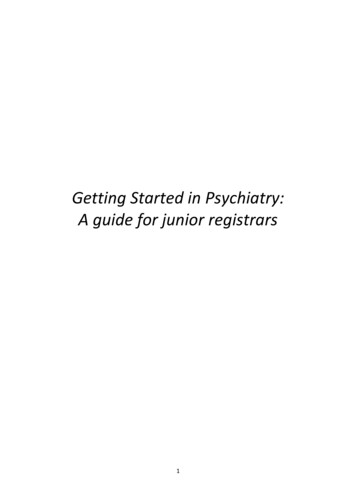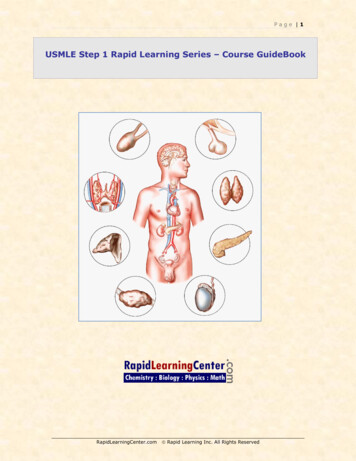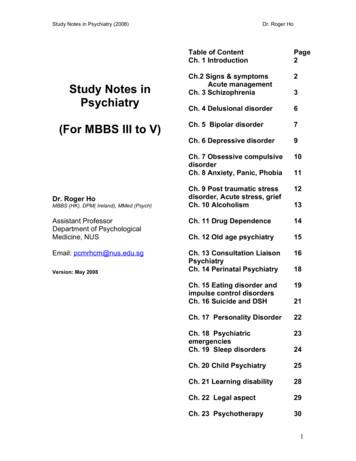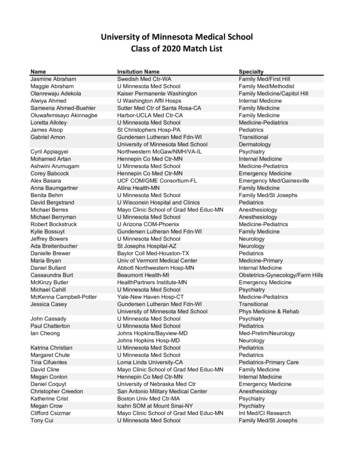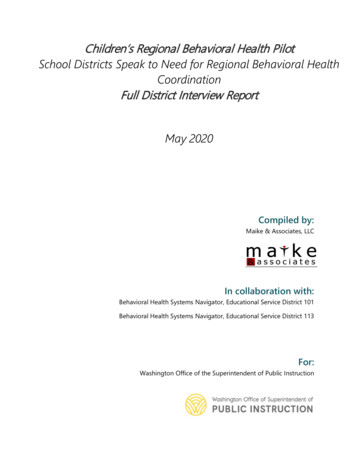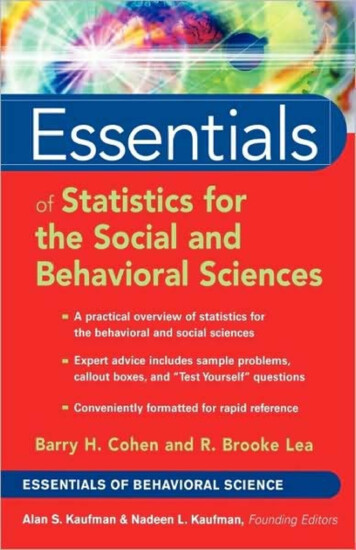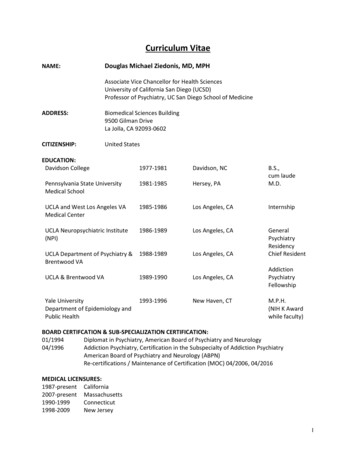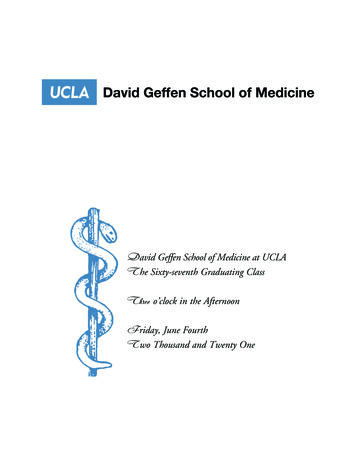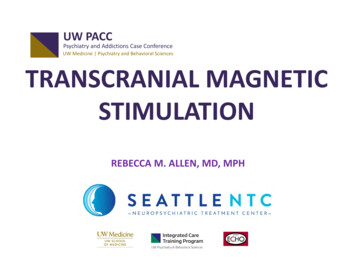
Transcription
UW PACCPsychiatry and Addictions Case ConferenceUW Medicine Psychiatry and Behavioral SciencesTRANSCRANIAL MAGNETICSTIMULATIONREBECCA M. ALLEN, MD, MPHUW PACC 2021 University of Washington
SPEAKER DISCLOSURES Any conflicts of interest? No relevant financial relationships to disclose I work at a clinic that offers TMS. I also am on the Board of the Clinical TMS Society andserve as its Treasurer and Chair of the InsuranceCommittee.UW PACC 2021 University of Washington
WHAT IS “INTERVENTIONALPSYCHIATRY?” “ an emerging subspecialty that utilizes neurotechnologies to identifydysfunctional brain circuitry underlying psychiatric disorders and apply brainstimulation techniques to modulate that circuitry.” (Williams, 2014)Treatment modalities include (* FDA approved)– TMS* –––––––cTBSiTBS*dTMS*ECT*Ketamine infusionsEsketamine (Spravato) nasal spray*VNS*DBStDCS. . . othersUW PACCWilliams N. Interventional Psychiatry: Why Now? J Clin Psychiatry. 2014 Aug; 75(8): 895‐897 2021 University of Washington
opic‐9‐funnel.svgSTUDY: Sequenced Treatment Alternatives To Relieve DepressionOnly 2/3 achieved remission after four medicationsUW PACC 2021 University of Washington
2003(note the absence of TMS on this graph)UW PACC 2021 University of Washington
2003TMS20UW PACC 2021 University of Washington
TRANSCRANIAL MAGNETICSTIMULATION (TMS)Delivery of focused magnetic field pulses of 1.0‐2.5 T through a coil placed overthe scalp Induces an electric current when it reaches the brain Modulates the activity of dysfunctional cortical regions that are stimulated andother brain regions functionally connected to the stimulation site UW PACC 2021 University of Washington
Faraday’s LawUW PACC 2021 University of Washington
1910 photographSilvanus Thompson testing thephysiological effect of a largealternating magnetic field.Induced phosphenes.UW PACC 2021 University of Washington
HOW DOES TMS WORK? Faraday’s Law– Changing magnetic field induceselectric current in a wire Brain is the “wire” Modulates activity andconnectivity in both– Target area– Distant interconnected areas May alter brain oscillatoryactivityKeck, M.E. 2007. Repetitive transcranial magnetic stimulation effects in vitro and in animal models. Transcranial Brain Stimulation for Treatment of Psychiatric Disorders, Marcolina, M.A. and Padberg, F. (Eds.) Advances in BiologicalPsychiatry, Vol. 23, Karger, Basel, Switzerland, pp. 18‐34.Leuchter, A. F., Cook, I. A., Jin, Y. & Phillips, B. The relationship between brain oscillatory activity and therapeutic effectiveness of transcranial magnetic stimulation in the treatment of major depressive disorder. Frontiers in HumanNeuroscience 7, (2013).UW PACC 2021 University of Washington
WHAT KINDS OFCOILS ARE THERE?Oh So Many Coils!Not many are used often.Very few FDAapproved/cleared.https://www.zzzdeng.netUW PACC 2021 University of Washington
COIL SHAPEMATTERSFIG. 2. Induced electric field on the grey matter and scalp due to (a) Figure-8 coil onthe vertex (b) Quadruple Butterfly Coil on vertex (c) Figure-8 coil on dorsolateralprefrontal cortex (d) Quadruple Butterfly Coil on dorsolateral prefrontal cortex.Published in: P. Rastogi; E. G. Lee; R. L. Hadimani; D. C. Jiles; AIP Advances 7, 056705 (2017)DOI: 10.1063/1.4973604Copyright 2016 Author(s)UW PACC 2021 University of Washington
Coil Shape MattersFIGURE‐OF‐8VERSUSH‐COILFeifel, David & Pappas, Katherine. (2016). Treating Clinical Depression with Repetitive Deep Transcranial Magnetic Stimulation Using the Brainsway H1‐coil. Journal of Visualized Experiments. 2016. 10.3791/53858.UW PACC 2021 University of Washington
APPROVED/CLEARED TMS COILSrTMS repetitive TMS,usuallyfigure‐of‐8 coilrTMSdTMSrTMSrTMSdTMS “deepTMS”Deng, Z.‐D., Lisanby, S. H. & Peterchev, A. V. Coil design considerations for deep transcranial magnetic stimulation. ClinicalNeurophysiology 125, 1202–1212 (2014).UW PACC 2021 University of Washington
APPROVED/CLEARED TMS COILSCool D‐B802020H4 Smoking Cessation2020SpringTMS d59 XL.jpgUW PACC 2021 University of Washington
HOW DO YOU DELIVER THE PULSES?Types: Repetitive transcranial magnetic stimulation (rTMS)* Deep transcranial magnetic stimulation (dTMS) (type of rTMS)* Intermittent theta‐burst stimulation (iTBS)* Continuous theta‐burst stimulation (cTBS)*FDA ApprovedUW PACC 2021 University of Washington
WHERE DO YOU PUT THE COIL? Left dorsolateral prefrontalcortex (L DLPFC)– Mood & anxiety disorders Supplementary motor area(SMA)– superficial target forObsessive CompulsiveDisorder (OCD) Anterior cingulate cortex(ACC)– deep target for OCD (dTMS) Many others have beenstudied for a variety ofdisordersUW PACC 2021 University of Washington
Brain Regions Altered by Depressionaan het Rot, M., Mathew, S. J. & Charney, D. S. Neurobiological mechanisms in major depressive disorder. Canadian Medical Association Journal 180, 305–313 (2009).UW PACC 2021 University of Washington
TMS SIDE EFFECTS Considered a minimal riskprocedure Headaches – 10‐15% Less common ( 5%)– Tenderness/discomfort atstimulation site– Muscle twitching (face,forehead)– Trigeminal pain (typicallyavoidable)– Lightheadedness Mania? in patients at risk (datamixed on whether this is a realconcern) Extremely rare – seizure (fewerthan 1 seizure per 60,000sessions) NO cognitive effects orrestrictions Precautions Ear protection required toprevent risk of hearing loss Magnet can move or heat upmetal within 30cmLerner, Adam J., Eric M. Wassermann, and Diana I. Tamir. “Seizures from Transcranial Magnetic Stimulation 2012–2016: Results of a Survey of Active Laboratories and Clinics.” Clinical Neurophysiology 130, no. 8 (August 1,2019): 1409–16. https://doi.org/10.1016/j.clinph.2019.03.016.UW PACC 2021 University of Washington
WHAT ABOUT SIDE EFFECTS INADOLESCENTS? N 322 receiving rTMS, manywith neurologic conditions–––––––Headache: 11.5%Scalp discomfort: 2.5%Twitching: 1.2%Mood changes: 1.2%Fatigue: 0.9%Tinnitus: 0.6%Generally resolve within 24hours 4 (1.2%) had major sideeffects– 2 (0.62%) seizures– 2 (0.62%) syncopeKrishnan, Santos, Peterson, & Ehinger. (2015). Safety of Noninvasive Brain Stimulation in Children and Adolescents. Brain Stimulation, 8(1), 76‐87.UW PACC 2021 University of Washington
WHO CANNOT HAVE TMS? Absolute– Magnetic metal within 30cm of the coil (most dental work OK; not all!) “Absolute”– Epilepsy that is active and not controlled– We have successfully and safely treated some patients with a remote history ofepilepsy or well‐controlled for years Relative– Pacemaker/AICD (would want to turn the device “off” during the treatment,e.g., with a magnet)– History of significant head trauma or brain surgery (due to relatively higher riskof seizure)– Recent stroke (due to relatively higher risk of seizure; BUT some studies onusing TMS to aid stroke recovery)– Active substance abuse (most studies using TMS to treat substance abuse haverequired some period of abstinence prior to TMS)UW PACC 2021 University of Washington
WHAT DO WE USE TMS FOR?FDA APPROVALS Children/teensAdults– Major depressive disorder (afterone failed antidepressant trial) Of “adequate dose and duration”– Adjunctive therapy for ObsessiveCompulsive Disorder (dTMS H7 orCool‐D‐B80 only)– Intermittent Theta‐Burststimulation (iTBS) for depressionUW PACC 2021 University of Washington
FDA‐APPROVED TMS DEPRESSIONTREATMENT PROTOCOL TARGET: left dorsolateral prefrontal cortex (L DLPFC)High frequency– 10 Hz or 18 Hz (depending on coil)– 1800‐3000 pulses per session (depending on the coil) Stimulus is “dosed” to brain’s sensitivity– “motor threshold” (see upcoming slide) Treatment Course for Standard Depression Protocol– 30 treatments– 5 days per week– 15‐20 minutes per treatment (varies by treatment site– ‘optimal’ protocol not known)– 6 treatment taperUW PACC 2021 University of Washington
HOW DO YOU FIND THE RIGHT DOSE?MOTOR THRESHOLDTitration of the stimulus “dose” to thesensitivity of the brain Based on elicited motor response (i.e.,twitching) with stimulation ofthumb/finger motor area “Motor threshold” Lowest pulsestrength which elicits 50% thumb twitch(out of 10 pulses, thumb twitches 5times) Treatment dose expressed as %MT(typically 120%) UW PACC 2021 University of Washington
UW PACC 2021 University of Washington
HOW DO YOU FIND THEDORSOLATERAL PREFRONTALCORTEX? DLPFC 5cm anterior to motor strip(least accurate) “Unfortunately, due to anatomicalvariability, this method of targeting ledto stimulation of premotor areas in upto 1/3 of patients, possibly accountingfor the low response rates seen in someearlier studies” Beam F3 MRI‐guided (most accurate, butleast available)Mir‐Moghtadaei, Caballero, Fried, Fox, Lee, Giacobbe, . . . Downar. (2015). Concordance Between BeamF3 and MRI‐neuronavigated Target Sites forRepetitive Transcranial Magnetic Stimulation of the Left Dorsolateral Prefrontal Cortex. Brain Stimulation, 8(5), 965‐973.Trevizol, Alisson P., and Daniel M. Blumberger. “An Update on Repetitive Transcranial Magnetic Stimulation for the Treatment of MajorDepressive Disorder.” Clinical Pharmacology and Therapeutics 106, no. 4 (October 2019): 747–62. https://doi.org/10.1002/cpt.1550.UW PACC 2021 University of Washington
DOES TMS WORK FOR DEPRESSION?7 RCTs, N 279 (171 active, 108 sham)Response (active) – 46.6%Response (sham) – 22.1%NNT 3.4I tell patients:“About 5‐6 out of every10 people respond.”Multisite, open‐label, observational studyN 307 patientsMean # failed antidepressant attempts 3.6Over 54% failed 2 antidepressant trialsLiu B, Zhang Y, Zhang L, Li L. Repetitive transcranial magnetic stimulation as an augmentative strategy for treatment‐resistant depression, a meta‐analysis of randomized, double‐blind and sham‐controlled study. BMC Psychiatry. 2014 Nov 30;14(1):342.Carpenter LL, Janicak PG, Aaronson ST, Boyadjis T, Brock DG, Cook IA, et al. Transcranial Magnetic Stimulation (TMS) for Major Depression: A Multisite, Naturalistic, Observational Study of Acute Treatment Outcomes in Clinical Practice. Depression and Anxiety.2012 Jul;29(7):587–96.UW PACC 2021 University of Washington
IS DTMS BETTER FOR DEPRESSION THAN RTMS?(THERE ARE MANY MORE RTMS STUDIES . . . AND ONLY ONE STUDY COMPARING THE TWOCOILS!)Levkovitz, Y. et al. Efficacy and safety of deep transcranial magnetic stimulation for major depression: a prospective multicenterrandomized controlled trial. World Psychiatry 14, 64–73 (2015).Filipčić I, Šimunović Filipčić I, Milovac Ž, et al. Efficacy of repetitive transcranial magnetic stimulation using a figure‐8‐coil or an H1‐Coil in treatment of major depressive disorder; A randomized clinical trial. Journal of Psychiatric Research. 4.020UW PACC 2021 University of Washington
HOW LONG DOES RTMS BENEFIT LAST FORDEPRESSION? A meta‐analysis on the length of time that rTMS effects last reported that,amongst responders:– 66.5% sustained response after 3 months– 52.9% sustained response after 6 months– 46.3% sustained response after 1 year (this is what I usually tell patients) One naturalistic study (N 204) reported relapse rates of:–––– 25% at 2 months40% at 3 months57% at 4 months77% at 6 monthsYet another study (N 257) reported a relapse rate of 30% over the first year–Relapse more likely in the first 6 months Re‐treatment tends to work (2‐3 week “booster” course) No evidence‐based guidelines for maintenance TMS treatmentsSenova, S., Cotovio, G. & Pascual‐leone, A. Brain Stimulation Durability of antidepressant response to repetitive transcranial magnetic stimulation : Systematic review and meta‐analysis. Brain Stimul.(2018).doi:10.1016/j.brs.2018.10.001Cohen, R. B., Boggio, P. S. & Fregni, F. Risk factors for relapse after remission with repetitive transcranial magnetic stimulation for the treatment of depression. Depress Anxiety 26, 682– 688 (2009).Dunner D, Aaronson ST, Sackeim HA, Janicak PG, Carpenter LL, Boyadjis T, et al. A Multisite, Naturalistic, Observational Study of Transcranial Magnetic Stimulation for Patients With Pharmacoresistant Major Depressive Disorder:Durability of Benefit Over a 1‐Year Follow‐Up Period. Journal of Clinical Psychiatry. 2014 Dec;75(12):1394–401.UW PACC 2021 University of Washington
WHAT ABOUT THETA BURST STIMULATION (TBS)? Approved 2018 for depression(MagVita system) Modification of rTMS device todeliver triplets of pulses at thetafrequency Mimics theta frequency ofneurons in the brain– Theta range refers to EEG wavesbetween 4‐7Hz in humansBlumberger, Daniel M, Fidel Vila‐Rodriguez, Kevin E Thorpe, Kfir Feffer, Yoshihiro Noda, Peter Giacobbe, Yuliya Knyahnytska, et al. “Effectiveness of Theta Burst versus High‐Frequency Repetitive Transcranial Magnetic Stimulationin Patients with Depression (THREE‐D): A Randomised Non‐Inferiority Trial.” The Lancet 391, no. 10131 (April 2018): 1683–92. UW PACC 2021 University of Washington
WHAT ABOUT THETA BURST STIMULATION (TBS)? Intermittent (iTBS) provides a twosecond train of bursts (30 pulses),repeated every 10 seconds. iTBS has been shown to causelong‐term potentiation‐like (LTP)effects of cortical excitability 3‐4 minute treatment theta‐burst showed essentiallyidentical efficacy to standard TMSprotocols for depressionBlumberger, Daniel M, Fidel Vila‐Rodriguez, Kevin E Thorpe, Kfir Feffer, Yoshihiro Noda, Peter Giacobbe, Yuliya Knyahnytska, et al. “Effectiveness of Theta Burst versus High‐Frequency Repetitive Transcranial Magnetic Stimulationin Patients with Depression (THREE‐D): A Randomised Non‐Inferiority Trial.” The Lancet 391, no. 10131 (April 2018): 1683–92. UW PACC 2021 University of Washington
AND BY “IDENTICAL,” I MEAN Intermittent Theta Burst TMS is equivalent tostandard protocol for depression in the shortterm.No good long‐term durability data available fortheta burst.Blumberger, Daniel M, Fidel Vila‐Rodriguez, Kevin E Thorpe, Kfir Feffer,Yoshihiro Noda, Peter Giacobbe, Yuliya Knyahnytska, et al. “Effectivenessof Theta Burst versus High‐Frequency Repetitive Transcranial MagneticStimulation in Patients with Depression (THREE‐D): A Randomised Non‐Inferiority Trial.” The Lancet 391, no. 10131 (April 2018): 30295‐2.UW PACC 2021 University of Washington
EFFICACY SUMMARY ‐ DEPRESSION In depression, typically estimated as 50‐60% chance of response inpatients who have failed 2 antidepressants (inclusive of remission)––––20‐30% chance of remission in same populationIrrespective of # of failed treatment trialsCompare to STAR*D 5‐6% likelihood of remission at 3rd‐4th stepMany studies include both bipolar and unipolar depression evidence for TMS for bipolar depression is mixed and conclusions are unclear– Studies are heterogeneous in their assessments and reporting ofresponse/remission– Current (limited) data suggests similar efficacy in adolescents (13 )Senova S, Cotovio G, Pascual‐Leone A, Oliveira Maia AJ. Durability of antidepressant response to repetitive transcranial magnetic stimulation: systematic review and meta‐analysis. Brain Stimulation [Internet]. 2018 Oct [cited2018 Oct 3]; Available from: 861X18303206Dunner D, Aaronson ST, Sackeim HA, Janicak PG, Carpenter LL, Boyadjis T, et al. A Multisite, Naturalistic, Observational Study of Transcranial Magnetic Stimulation for Patients With Pharmacoresistant Major Depressive Disorder:Durability of Benefit Over a 1‐Year Follow‐Up Period. Journal of Clinical Psychiatry. 2014 Dec;75(12):1394–401.UW PACC 2021 University of Washington
EFFICACY SUMMARY ‐ DEPRESSION Durability estimates range from 46.3% (Senova et al,2018) to 70% (Dunner et al, 2017) at 1 year– A small study (Mayer, et al) showed 3‐year durability ofresults in 8 adolescents (now in early 20s) at 3 yearsSenova S, Cotovio G, Pascual‐Leone A, Oliveira Maia AJ. Durability of antidepressant response to repetitive transcranial magnetic stimulation: systematic review and meta‐analysis. Brain Stimulation [Internet]. 2018 Oct [cited2018 Oct 3]; Available from: 861X18303206Dunner D, Aaronson ST, Sackeim HA, Janicak PG, Carpenter LL, Boyadjis T, et al. A Multisite, Naturalistic, Observational Study of Transcranial Magnetic Stimulation for Patients With Pharmacoresistant Major Depressive Disorder:Durability of Benefit Over a 1‐Year Follow‐Up Period. Journal of Clinical Psychiatry. 2014 Dec;75(12):1394–401.UW PACC 2021 University of Washington
TMS forObsessiveCompulsiveDisorderStein, Dan J., Daniel L. C. Costa, Christine Lochner, Euripedes C. Miguel, Y. C. Janardhan Reddy, Roseli G. Shavitt, Odile A. van den Heuvel, and H. Blair Simpson. “Obsessive–Compulsive Disorder.” Nature Reviews Disease Primers 5,no. 1 (August 1, 2019): 1–21. https://doi.org/10.1038/s41572‐019‐0102‐3.UW PACC 2021 University of Washington
OBSESSIVE COMPULSIVE DISORDERFigure‐of‐8 targetFigure‐of‐8 targetH7 Coil targetWilliams NR et al. 2018UW PACC 2021 University of Washington
TMS FOR OCD Multiple studies using rTMS and figure‐of‐8 coils to treat OCD . . . HOWEVER the only current FDA approved protocol is using dTMSwith a Brainsway helmet OR the same protocol using the Cool D‐B80MagVenture coil Brain targets from various OCD studies–––––Right dorsolateral prefrontal cortexLeft dorsolateral prefrontal cortexSupplementary motor areaRight orbitofrontal cortexSome combinations of the above (for example, bilateral DLPFC, or R‐DLPFC plus SMA)UW PACC 2021 University of Washington
TMS FOROCDMany studiesusing figure‐of‐8coilsRehn, Simone, Guy D. Eslick, andVlasios Brakoulias. “A Meta‐Analysisof the Effectiveness of DifferentCortical Targets Used in RepetitiveTranscranial Magnetic Stimulation(RTMS) for the Treatment ofObsessive‐Compulsive Disorder(OCD).” Psychiatric Quarterly 89, no.3 (September 2018): 66‐7.UW PACC 2021 University of Washington
TMS FOR OCD: BRAINSWAY PROTOCOL,FDA APPROVEDMeta‐analyses of figure‐of‐8 studies prior toFDA approval of Brainsway protocol werepromising Then along came Brainsway/dTMS – FDAapproval in 2018 as adjunct for OCD, overmPFC and ACC – And similar coil approved in 2020 for usewith the same protocol: the Cool D‐B80from MagVenture dTMS/D‐B80 protocol uses “PERSONALIZEDSYMPTOM PROVOCATION” beforetreatment– Theory: use the circuit during treatmentPicture from: Popa, Traian, Laurel S. Morris, Rachel Hunt, Zhi‐De Deng, Silvina Horovitz, Karin Mente, Hitoshi Shitara, Kwangyeol Baek, Mark Hallett, and Valerie Voon. “Modulation of Resting Connectivity Between the MesialFrontal Cortex and Basal Ganglia.” Preprint. Neuroscience, October 1, 2018. https://doi.org/10.1101/432609.UW PACC 2021 University of Washington
OBSESSIVE COMPULSIVE DISORDER 11 centers in RCT99 OCD patientsAllocated to 20 Hz or sham dTMSActive dTMS response was 6.0 points onYBOCS & sham dTMS response was 3.3pointsResponse rate was 38.1% in active and11.1% in sham.1‐month follow up had higher response ratesof 45.2% in active group and 17.8% in shamgroup.Carmi, Lior, Aron Tendler, Alexander Bystritsky, Eric Hollander, Daniel M. Blumberger, Jeff Daskalakis, Herbert Ward, et al. “Efficacy and Safety of Deep Transcranial Magnetic Stimulation for Obsessive‐Compulsive Disorder: AProspective Multicenter Randomized Double‐Blind Placebo‐Controlled Trial.” American Journal of Psychiatry, May 21, 2019, appi.ajp.2019.1. https://doi.org/10.1176/appi.ajp.2019.18101180.UW PACC 2021 University of Washington
TMS FOR OCDCarmi, Lior, Aron Tendler, Alexander Bystritsky, Eric Hollander, Daniel M. Blumberger, Jeff Daskalakis, Herbert Ward, et al. “Efficacy and Safety of Deep Transcranial Magnetic Stimulation for Obsessive‐Compulsive Disorder: AProspective Multicenter Randomized Double‐Blind Placebo‐Controlled Trial.” American Journal of Psychiatry, May 21, 2019, appi.ajp.2019.1. https://doi.org/10.1176/appi.ajp.2019.18101180.UW PACC 2021 University of Washington
EFFICACY SUMMARY ‐ OCD In OCD, 30‐40% chance of response (30% reduction),best used as adjunct to exposure therapy andmedications.– Remission is rare, as is the case with SSRI treatment– Effect sizes are modest (Y‐BOCS reduction 6‐9), againsimilar to SSRI Large, long‐term durability studies are not yet availableUW PACC 2021 University of Washington
INSURANCE REQUIREMENTS FOR TMSFOR DEPRESSION Age 18 ( 18 is case‐by‐case) Unipolar major depressive disorder– Often “severe” depression (clinically or by rating scales) Multiple medication failures “of adequate dose and duration”– Typically 4 antidepressants from 2 classes– Some allow 3 antidepressants from 2 classes 2 differentaugmenting strategies– OR not tolerated due to side effects/inability to take pills– Medicare requires 1 failed antidepressant in the current episode or 2failures due to side effects Failed a trial of evidence‐based psychotherapy (usually 12 sessions) Depression severe enough to warrant ECT, but ECT not feasibleUW PACC 2021 University of Washington
INSURANCE REQUIREMENTS FOR TMSFOR OBSESSIVE COMPULSIVE DISORDER(this slide is left intentionally blank . . . . )UW PACC 2021 University of Washington
THE FUTURE OF TMS Approaches to increase the efficacy of the standard form of rTMSinclude:– (1) combining protocols;– (2) improving localization of the targeted cortical regions using onlineneuronavigation;– (3) new coils, with deeper, and broader or more focal stimulation;– (4) new patterns of stimulation, including theta‐burst stimulation (TBS)and priming TMS (pTMS);– (5) targeting newer cortical regions other than the DLPFC in MDD;– (6) and identifying clinical predictors of response. Extended courses (45‐60 treatments) and condensed courses (2‐3treatments per day for fewer total weeks of treatment) for depressionMore indicationsUW PACC 2021 University of Washington
ACCELERATED PROTOCOLS FOR DEPRESSION Twice‐daily rTMS can achieve similar response andremission rates at the end of the course, with 35.4% and33.8% , and 41.5% and 35.4%, response and remission ratesfor once‐daily and twice‐daily rTMS sessions, respectively Other studies (at least 12 total) looking at more than 1 TMStreatment per day have varied widely in the number oftreatments per day. Some with 3 times per day, some withmore. Highest number studied is 10 sessions per day. Mostly positive results; no long‐term data yet on durability.Schulze, L. et al. Brain Stimulation Number of pulses or number of sessions ? An open‐label study of trajectories of improvement for once‐vs . twice‐daily dorsomedial prefrontal rTMS in major depression. 11, 327–336 (2018).Sonmez, A. Irem, Deniz Doruk Camsari, Aiswarya L. Nandakumar, Jennifer L. Vande Voort, Simon Kung, Charles P. Lewis, and Paul E. Croarkin. “Accelerated TMS for Depression: A Systematic Review and Meta‐Analysis.” PsychiatryResearch 273 (March 2019): 770–81. https://doi.org/10.1016/j.psychres.2018.12.041.UW PACC 2021 University of Washington
DISORDERS OTHER THAN DEPRESSIONCONCLUSIONS FROM A REVIEW BY EUROPEAN EXPERTSDATA THROUGH 2018Level A:–––Level C:Major Depressive Disorder (previouslyconcluded by the group)Neuropathic painMotor strokeLevel B:––––––FibromyalgiaParkinson’s diseaseMotor strokePost‐stroke aphasiaMultiple sclerosisPost‐traumatic Stress Disorder––––––––––CRPS type 1Motor StrokeHemispatial neglectEpilepsyAlzheimer’s DiseaseTinnitusObsessive‐Compulsive Disorder (FDAcleared 2019 multicenter RCT)Schizophrenia: auditory hallucinationsSchizophrenia: negative symptomsAddiction & CravingNote the absence of bipolar disorder . . .Lefaucheur J‐P, Aleman A, Baeken C, et al. Evidence‐based guidelines on the therapeutic use of repetitive transcranialmagnetic stimulation (rTMS): An update (2014–2018). Clinical Neurophysiology. Published online January2020:S1388245719312799. doi:10.1016/j.clinph.2019.11.002UW PACC 2021 University of Washington
SMOKING CESSATION? Randomized study of 262 subjects H4 Deep TMS coil (Insula and PFC) treatments were performed daily, five days aweek for 3 weeks, followed by an additional 3sessions once a week for 3 weeks (for a totalof 18 sessions over the course of 6 weeks). four-week continuous quit rate was 28.4% inthe active Deep TMS group compared to11.7% in the sham group (p 0.0063) The FDA issued a 510(k) clearance in ‐Adults.htmlUW PACC 2021 University of Washington
SMOKING CESSATION?Tendler A, Barnea Ygael N, Roth Y, Zangen A. Deep transcranial magnetic stimulation (dTMS) – beyond depression.Expert Review of Medical Devices. 2016;13(10):987‐1000. doi:10.1080/17434440.2016.1233812UW PACC 2021 University of Washington
WHY IT IS HARD TO STUDY TMS FOR ANEW INDICATION SO MANY PROTOCOL PARAMETERS!–––––––– Intensity relative to the motor threshold (MT) (for example, 120%MT)Frequency (1 Hz, 10 Hz, 18 Hz)Number of pulsesNumber of sessionsTrain and inter‐train durationpattern of stimulationcoil type and orientationcortical region targetedDifferent stimulation frequencies and patterns exert different effects, notalways in a consistent fashion“While the ability to manipulate multiple parameters creates a tremendousopportunity for innovation, it also poses challenges regarding understandingvariability in response to the treatment”Trevizol, Alisson P., and Daniel M. Blumberger. “An Update on Repetitive Transcranial Magnetic Stimulation for the Treatment of Major Depressive Disorder.” Clinical Pharmacology and Therapeutics 106, no. 4 (October2019): 747–62. https://doi.org/10.1002/cpt.1550.UW PACC 2021 University of Washington
TMS, IN SUMMARYPros Extremely safe, including in teensFor MDD––– Far more effective than 4th medicationtreatment trial ( 50‐60% vs 5%)Durable effects (about 50% maintain at1 yearCovered by insurance for MDD30‐40% chance of response in OCD– ConsNot insurance covered (as of 2020)Some other indications with goodevidence for off‐label use– Logistically burdensomeLess effective than ECT ( 45‐60% vs 70‐80%)Most insurances do not cover non‐MDD diagnosesPremera/BXBS cover some 18 y/o,o/w case‐by‐caseExpensive if out of pocket ( 9,000‐ 18,000 for 36 sessions; most clinicscharge 250‐ 500 per treatment)For example, PTSDUW PACC 2021 University of Washington
ACKNOWLEDGMENTS Thanks to all our colleagues at SeattleNTC:Leigh Brown DOKi Won Nam MDSteve Brogdon MDJesse Adams MD (borrowed/adapted some of hisslides)– Rie Sharky MD– Laurie Arndorfer MD––––UW PACC 2021 University of Washington
UW PACCPsychiatry and Addictions Case ConferenceUW Medicine Psychiatry and Behavioral SciencesTHANK YOU!REBECCA.ALLEN@SEATTLENTC.COMSEATTLE NEUROPSYCHIATRIC TREATMENT CENTER (SEATTLENTC)WWW.SEATTLENTC.COM206‐467‐6300UW PACC 2021 University of Washington
HOW TO REFER A patient or referring provider may contact SeattleNTC toschedule a consultation at:––––206‐467‐6300 x7 (phone)206‐467‐6301 (fax)info@seattlentc.comwww.seattlentc.com We accept essentially all major insurance plans Our ECT program is performed in conjunction with SwedishMedical Centers, specifically at the Ballard & Issaquah campuses TMS & esketamine are provided in our office locations– Seattle, Bellevue, Tacoma, BellinghamUW PACC 2021 University of Washington
Feifel, David & Pappas, Katherine. (2016). Treating Clinical Depression with Repetitive Deep Transcranial Magnetic Stimulation Using the Brainsway H1‐coil. Journal of Visualized Experiments.

